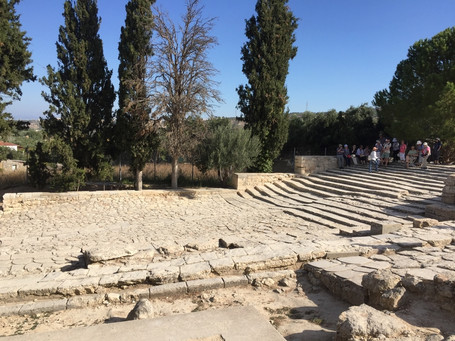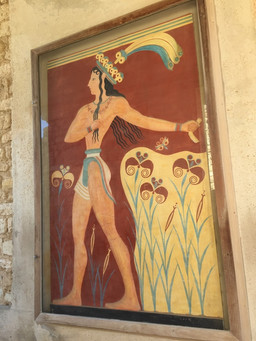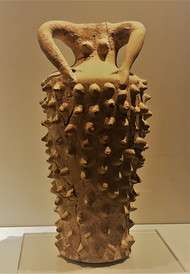The Treasures of Minoan Crete
- Angela Wallis Moore

- Jan 7, 2022
- 3 min read
Updated: Jan 12, 2022
On a warm autumn day in October 2017, I gazed from the window of the plane as islands of the Cyclades drifted far below, their peaks wreathed in cloud.

I was excited, filled with anticipation, for this was my first trip to Greece. More than that, this was the fulfilment of a dream – to spend time in Crete to immerse myself in the ambience of the land, the remnants of the Minoan Empire, and the wonderful Cretan myths. As an author and retired psychotherapist, I’m fascinated by the capacity of archetypal stories to influence modern lives, and much of my writing is infused with this concept.
There are places in this world where the frontiers of reality and myth overlap; I sought evidence of this liminality in Crete, and I was not disappointed.
Once established in the charming boutique hotel just a short stroll from the harbour, I wandered down to the promenade to watch the sunset. Lights twinkled on picturesque fishing boats, and a roseate sky cast purple shadows on the Venetian fort at the end of the causeway.


Everywhere I saw fragments of the past - crumbling ruins thrusting long fingers through the dusty earth,

… and, later, I wrote of the pervasive influence of the past, in Children of the Gods:
“Away from the noise and bustle, the roar of traffic, the voices of tourists and locals, he could feel the ancient, brooding presence beneath the shabby beauty of the island. He felt it in the bones of the mountains, in the black silhouette of Strouboulas, its pyramidal shape etched against a saffron sky.
A church bell tolled, and he turned his head. Christianity covered the land, and yet, despite the chapels and shrines on every hillside, atop every mountain, the ancient world was clearly discernible through the veil. Never more than a spade’s depth below the arid topsoil, every excavation brought to light another fragment of the past.
The old gods turn restlessly in their sleep.”

Suitably primed by the ambience of the island, I arranged a visit to Knossos, the purported location of the Minotaur’s labyrinth. The origins of Knossos are lost, and its connection with the Minoans fiercely debated, but it’s known to be the largest Bronze Age archaeological site on Crete and has been called Europe's oldest city.
Regardless of the facts, Knossos possesses a powerful atmosphere. The very stones speak of antiquity, and one can imagine the blast of conches and the tramp of marching feet along the Corridor of Procession.
I spent hours wandering the avenues and inspecting the restorations ...
... before returning to Heraklion and the Knossos Museum … and there I found the art treasures of that ancient culture.
I was captivated by the sophistication of their art and their obsession with bovine imagery, including their predilection for Bull Leaping, a sport enjoyed by young people of both sexes.
Words cannot do justice to the experience of viewing artefacts from this fascinating era, in which mythos insinuates itself into the little factual knowledge we have of the people who once inhabited this ancient place. How did they live? What was the tenor of their everyday lives? Were they as peace-loving as generally believed, or a warlike people more recently described by current scholarship?
I hope to return. I long to spend more time on this timeless island – to explore Phaistos and Malia and enrich my understanding of the Bronze Age people who created the very first complex urban civilization in Europe.












































































Comments